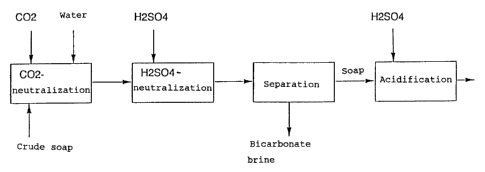Une partie des informations de ce site Web a été fournie par des sources externes. Le gouvernement du Canada n'assume aucune responsabilité concernant la précision, l'actualité ou la fiabilité des informations fournies par les sources externes. Les utilisateurs qui désirent employer cette information devraient consulter directement la source des informations. Le contenu fourni par les sources externes n'est pas assujetti aux exigences sur les langues officielles, la protection des renseignements personnels et l'accessibilité.
L'apparition de différences dans le texte et l'image des Revendications et de l'Abrégé dépend du moment auquel le document est publié. Les textes des Revendications et de l'Abrégé sont affichés :
| (12) Brevet: | (11) CA 2184244 |
|---|---|
| (54) Titre français: | TRAITEMENT DU SAVON DE TALLOL |
| (54) Titre anglais: | TREATMENT OF TALL OIL SOAP |
| Statut: | Réputé périmé |
| (51) Classification internationale des brevets (CIB): |
|
|---|---|
| (72) Inventeurs : |
|
| (73) Titulaires : |
|
| (71) Demandeurs : |
|
| (74) Agent: | NORTON ROSE FULBRIGHT CANADA LLP/S.E.N.C.R.L., S.R.L. |
| (74) Co-agent: | |
| (45) Délivré: | 2005-04-26 |
| (86) Date de dépôt PCT: | 1995-02-28 |
| (87) Mise à la disponibilité du public: | 1995-09-08 |
| Requête d'examen: | 2002-02-07 |
| Licence disponible: | S.O. |
| (25) Langue des documents déposés: | Anglais |
| Traité de coopération en matière de brevets (PCT): | Oui |
|---|---|
| (86) Numéro de la demande PCT: | PCT/FI1995/000107 |
| (87) Numéro de publication internationale PCT: | WO1995/023837 |
| (85) Entrée nationale: | 1996-08-27 |
| (30) Données de priorité de la demande: | ||||||
|---|---|---|---|---|---|---|
|
L'invention concerne un procédé pour améliorer la séparation de l'eau au cours du processus de préparation de tallol. Ce procédé comprend une étape de neutralisation au cours de laquelle un mélange de savon et d'eau est neutralisé avec du gaz carbonique, une étape de séparation de l'eau au cours de laquelle la phase aqueuse contenant du bicarbonate est séparée du savon, et une étape de cuisson au cours de laquelle le savon obtenu dans l'étape précédente est cuit avec de l'acide sulfurique pour former du tallol. L'amélioration de la procédure se caractérise par une deuxième neutralisation effectuée avec de l'acide sulfurique, après la neutralisation avec le gaz carbonique, mais avant l'étape de séparation de l'eau. L'invention concerne également un procédé comprenant les étapes présentées ci-dessus, pour la préparation du tallol.
The invention relates to a method for improving the separation of water in a tall oil preparation process which comprises: a
neutralization stage in which a mixture of soap and water is neutralized with carbon dioxide, a water separation stage in which the aqueous
phase containing bicarbonate is separated from the soap, and a cooking stage in which the soap obtained from the preceding stage is cooked
with sulfuric acid to form tall oil, the improvement comprising the procedure that, after the neutralization with carbon dioxide but before
the water separation stage, a second neutralization with sulfuric acid is carried out. The invention also relates to a process comprising the
stages presented above for the preparation of tall oil.
Note : Les revendications sont présentées dans la langue officielle dans laquelle elles ont été soumises.
Note : Les descriptions sont présentées dans la langue officielle dans laquelle elles ont été soumises.

Pour une meilleure compréhension de l'état de la demande ou brevet qui figure sur cette page, la rubrique Mise en garde , et les descriptions de Brevet , États administratifs , Taxes périodiques et Historique des paiements devraient être consultées.
| Titre | Date |
|---|---|
| Date de délivrance prévu | 2005-04-26 |
| (86) Date de dépôt PCT | 1995-02-28 |
| (87) Date de publication PCT | 1995-09-08 |
| (85) Entrée nationale | 1996-08-27 |
| Requête d'examen | 2002-02-07 |
| (45) Délivré | 2005-04-26 |
| Réputé périmé | 2013-02-28 |
Il n'y a pas d'historique d'abandonnement
Les titulaires actuels et antérieures au dossier sont affichés en ordre alphabétique.
| Titulaires actuels au dossier |
|---|
| L'AIR LIQUIDE, SOCIETE ANONYME POUR L'ETUDE ET L'EXPLOITATION DES PROCEDES GEORGES CLAUDE |
| Titulaires antérieures au dossier |
|---|
| L'AIR LIQUIDE SOCIETE ANONYME A DIRECTOIRE ET CONSEIL DE SURVEILLANCE POUR L'ETUDE ET L'EXPLOITATION DES PROCEDES GEORGES CLAUDE |
| L'AIR LIQUIDE, SOCIETE ANONYME POUR L'ETUDE ET L'EXPLOITATION DES PROCEDES GEORGES CLAUDE |
| OY METSA-BOTNIA AB |
| OY POLARGAS AB |
| ROUVINEN, TELLERVO |
| VARILA, ELIAS |